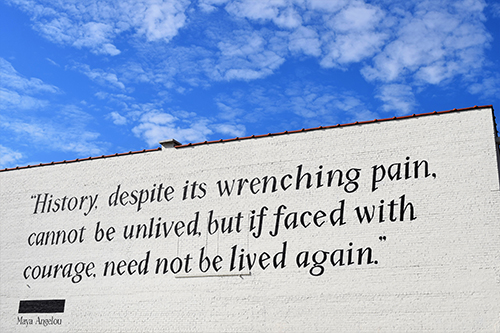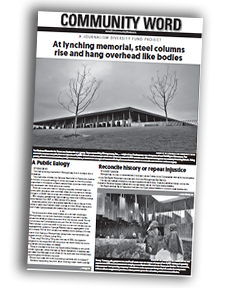
The Equal Justice Initiative uses a combination of poetry, design, research, emotion and historic facts to convey America’s legacy of racial violence and discrimination. This verse of a Maya Angelou poem is on the outside of the Legacy Museum: From Enslavement to Mass Incarceration. (PHOTO BY JILL FRIEDMAN FOR COMMUNITY WORD)
American history is shrouded in stereotypes and false accounts that cripple our ability to move forward and achieve a just and equitable society. In a recent survey, 92 percent of middle school children did not know slavery was a central issue of the Civil War.
But, like the lion and the hunter, the tale will never be told accurately until the hunter’s account is truthfully reconciled with the lion’s.
Toward that goal, two new museums unlike any other in our nation opened in April and provide hope for understanding injustice and hope America will be able to tackle its racist culture.
The Equal Justice Initiative in Montgomery, Ala., developed The National Memorial for Peace and Justice and The Legacy Museum: From Enslavement to Mass Incarceration.
Through a combination of exhibits, design, architecture, sculpture, poetry, literature, emotion and fact, the historical truth of the United States emerges with gut wrenching clarity.
Peoria writers Pam Adams and Sherry Cannon traveled to Montgomery in November to spend several days at these museums, and their accounts are documented in this special Community Word supplement.
Why is it important to understand America’s true history? Why revisit the past? Why re-open old wounds?
Because a society built on racism and lies by omission stands on a faulty foundation. The looming collapse hurts not just some but all.
In this eight-page supplement, Adams and Cannon report to the Peoria community what they discovered in Montgomery, what they learned through additional research and why this knowledge is essential for our community and our nation.
“Truth is not pretty, it’s not easy, but truth and reconciliation are sequential, so you need to get to the truth first,” said Bryan Stevenson, founder of the Equal Justice Initiative.
Reporting for this special supplement was underwritten by the Journalism Diversity Fund established at the Peoria NAACP with input from Community Word and a major donation from Terry Galvin Matthews along with additional donations from Andrew Hale, Jean and Sam Polk, Ken and Cheryl Hofbauer, Elaine and George Hopkins, Nancy Long and Clare Howard.
Printing the supplement was financed in part by a donation from Doug Stephens.


Recent Comments